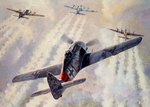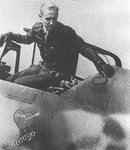remoraptor
Airman
- 15
- Dec 13, 2004
The bottom line for me is Erich Hartmann took out seven USAAF Mustangs.
Some folks say that the quality of Soviet aircraft and pilots was a main factor for the high scores achieved by the Luftwaffe aces in the East. This might have been true in the early part of the war in Russia but by the time Hartmann started making his reputation the Russians already had first-rate fighters and were receiving lend-lease material from the British and the USA.
If the quality of the opposition was a factor for the Germans' high scores then it would also be true for the Allies'. This is especially true for the RAF and USAAF pilots in the closing stages of the European war were many German pilots were hastily trained to fill the vacuum of accumulated casualties; and in the later part of the Pacific War were the Japanese finally decided to make use of their half-trained pilots as kamikaze so that at least they could do some damage before they were lost.
Some folks say that the quality of Soviet aircraft and pilots was a main factor for the high scores achieved by the Luftwaffe aces in the East. This might have been true in the early part of the war in Russia but by the time Hartmann started making his reputation the Russians already had first-rate fighters and were receiving lend-lease material from the British and the USA.
If the quality of the opposition was a factor for the Germans' high scores then it would also be true for the Allies'. This is especially true for the RAF and USAAF pilots in the closing stages of the European war were many German pilots were hastily trained to fill the vacuum of accumulated casualties; and in the later part of the Pacific War were the Japanese finally decided to make use of their half-trained pilots as kamikaze so that at least they could do some damage before they were lost.


